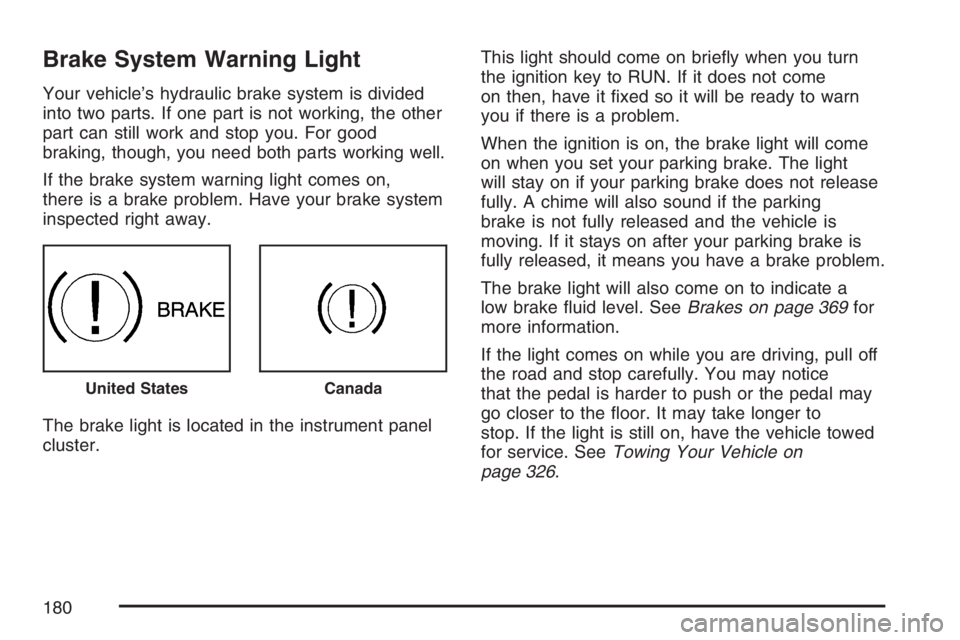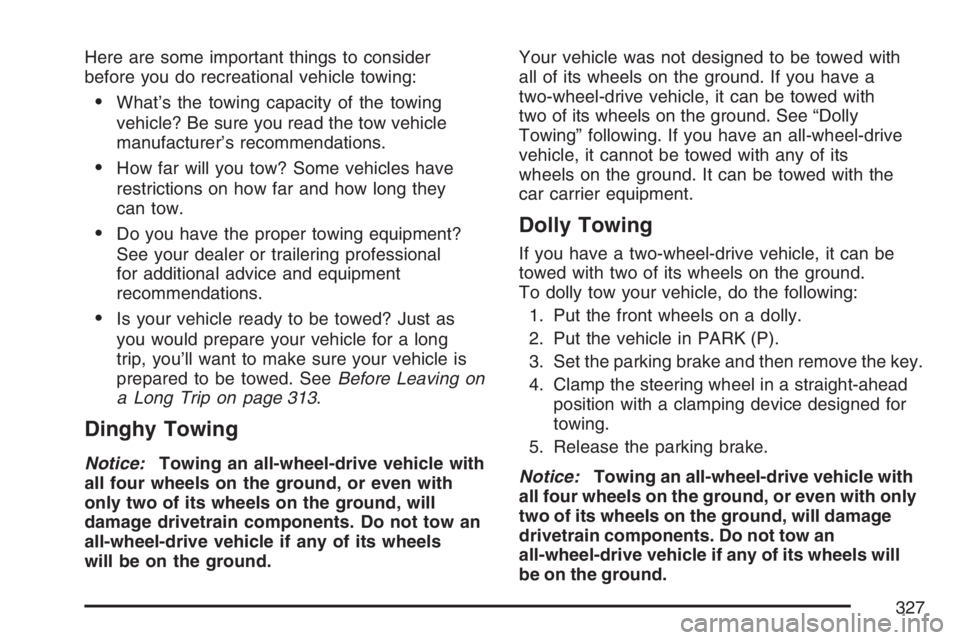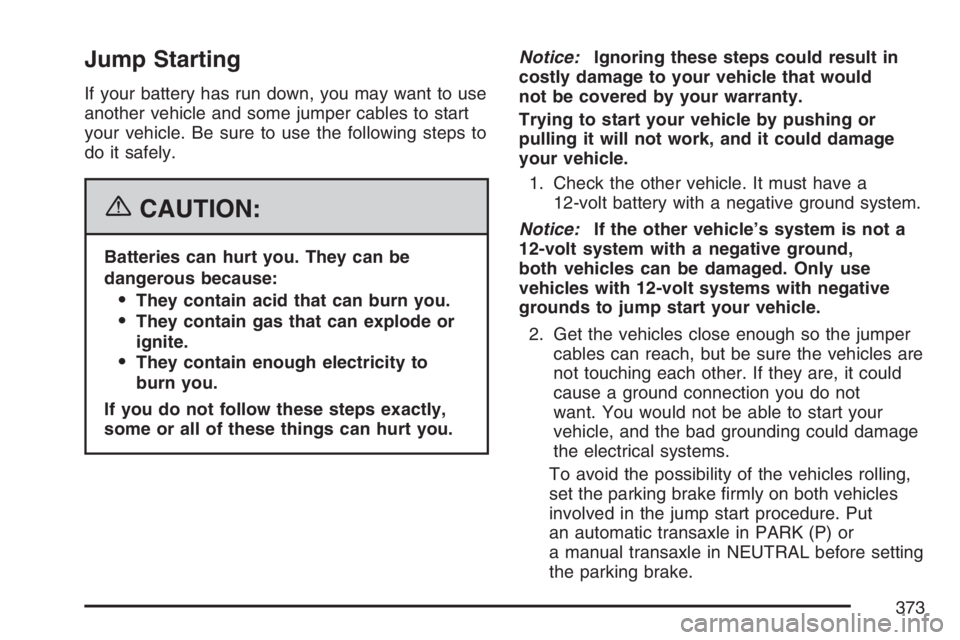2007 PONTIAC TORRENT parking brake
[x] Cancel search: parking brakePage 160 of 490

Daytime Running Lamps (DRL)
Daytime Running Lamps (DRL) can make it easier
for others to see the front of your vehicle during the
day. DRL can be helpful in many different driving
conditions, but they can be especially helpful in the
short periods after dawn and before sunset. Fully
functional Daytime Running Lamps (DRL) are
required on all vehicles �rst sold in Canada.
The DRL system will make your low-beam
headlamps come on at a reduced brightness in
daylight when the following conditions are met:
The ignition is on.
The exterior lamp band is in the automatic
position.
The transaxle is not in PARK (P).
The light sensor determines it is daytime.
The parking brake is released.
When the DRL are on, the low-beam headlamps
will be on at a reduced brightness. The taillamps,
sidemarker and other lamps will not be on.
The instrument panel will not be lit up either.When you turn the exterior lamp band to the
headlamp position, your low-beam headlamps will
come on. The other lamps that come on with
your headlamps will also come on.
When you turn off the headlamps, the regular
lamps will go off, and your low-beam headlamps
will come on to the reduced brightness.
To idle your vehicle with the DRL off, move the
shift lever to PARK (P). The DRL will stay off until
you move the shift lever out of PARK (P).
As with any vehicle, you should turn on the regular
headlamp system when you need it.
Automatic Headlamp System
When it is dark enough outside and the exterior
lamps control is in the automatic position, the
headlamps will come on automatically. See
Headlamps on page 159.
Your vehicle has a light sensor located on top of
the instrument panel. Make sure it is not covered,
or the headlamps will be on when you do not
need them.
The system may also turn on the headlamps when
driving through a parking garage or tunnel.
160
Page 180 of 490

Brake System Warning Light
Your vehicle’s hydraulic brake system is divided
into two parts. If one part is not working, the other
part can still work and stop you. For good
braking, though, you need both parts working well.
If the brake system warning light comes on,
there is a brake problem. Have your brake system
inspected right away.
The brake light is located in the instrument panel
cluster.This light should come on brie�y when you turn
the ignition key to RUN. If it does not come
on then, have it �xed so it will be ready to warn
you if there is a problem.
When the ignition is on, the brake light will come
on when you set your parking brake. The light
will stay on if your parking brake does not release
fully. A chime will also sound if the parking
brake is not fully released and the vehicle is
moving. If it stays on after your parking brake is
fully released, it means you have a brake problem.
The brake light will also come on to indicate a
low brake �uid level. SeeBrakes on page 369for
more information.
If the light comes on while you are driving, pull off
the road and stop carefully. You may notice
that the pedal is harder to push or the pedal may
go closer to the �oor. It may take longer to
stop. If the light is still on, have the vehicle towed
for service. SeeTowing Your Vehicle on
page 326.
United StatesCanada
180
Page 327 of 490

Here are some important things to consider
before you do recreational vehicle towing:
What’s the towing capacity of the towing
vehicle? Be sure you read the tow vehicle
manufacturer’s recommendations.
How far will you tow? Some vehicles have
restrictions on how far and how long they
can tow.
Do you have the proper towing equipment?
See your dealer or trailering professional
for additional advice and equipment
recommendations.
Is your vehicle ready to be towed? Just as
you would prepare your vehicle for a long
trip, you’ll want to make sure your vehicle is
prepared to be towed. SeeBefore Leaving on
a Long Trip on page 313.
Dinghy Towing
Notice:Towing an all-wheel-drive vehicle with
all four wheels on the ground, or even with
only two of its wheels on the ground, will
damage drivetrain components. Do not tow an
all-wheel-drive vehicle if any of its wheels
will be on the ground.Your vehicle was not designed to be towed with
all of its wheels on the ground. If you have a
two-wheel-drive vehicle, it can be towed with
two of its wheels on the ground. See “Dolly
Towing” following. If you have an all-wheel-drive
vehicle, it cannot be towed with any of its
wheels on the ground. It can be towed with the
car carrier equipment.
Dolly Towing
If you have a two-wheel-drive vehicle, it can be
towed with two of its wheels on the ground.
To dolly tow your vehicle, do the following:
1. Put the front wheels on a dolly.
2. Put the vehicle in PARK (P).
3. Set the parking brake and then remove the key.
4. Clamp the steering wheel in a straight-ahead
position with a clamping device designed for
towing.
5. Release the parking brake.
Notice:Towing an all-wheel-drive vehicle with
all four wheels on the ground, or even with only
two of its wheels on the ground, will damage
drivetrain components. Do not tow an
all-wheel-drive vehicle if any of its wheels will
be on the ground.
327
Page 334 of 490

Turn Signals When Towing a Trailer
When you tow a trailer, your vehicle has to have
extra wiring.
The arrows on your instrument panel will �ash
whenever you signal a turn or lane change.
Properly hooked up, the trailer lamps will also
�ash, telling other drivers you are about to turn,
change lanes or stop.
When towing a trailer, the arrows on your
instrument panel will �ash for turns even if the bulbs
on the trailer are burned out. Thus, you may think
drivers behind you are seeing your signal when
they are not. It’s important to check occasionally to
be sure the trailer bulbs are still working.
Driving On Grades
Reduce speed and shift to a lower gear before
you start down a long or steep downgrade. If you
do not shift down, you might have to use your
brakes so much that they would get hot and
no longer work well.If you are towing a trailer that weighs more than
1,000 lbs (450 kg), drive in INTERMEDIATE (I)
instead of DRIVE (D) or, as you need to, a lower
gear. This will minimize heat build-up and
extend the life of your transaxle.
Parking on Hills
{CAUTION:
You really should not park your vehicle,
with a trailer attached, on a hill. If
something goes wrong, your rig could
start to move. People can be injured, and
both your vehicle and the trailer can be
damaged.
But if you ever have to park your rig on a hill, do
the following:
1. Apply your regular brakes, but do not shift into
PARK (P) yet.
2. Have someone place chocks under the trailer
wheels.
334
Page 335 of 490

3. When the wheel chocks are in place,
release the regular brakes until the chocks
absorb the load.
4. Reapply the regular brakes. Then apply your
parking brake, and then shift to PARK (P).
5. Release the regular brakes.
When You Are Ready to Leave After
Parking on a Hill
1. Apply your regular brakes and hold the pedal
down while you do the following:
Start your engine.
Shift into a gear.
Release the parking brake.
2. Let up on the brake pedal.
3. Drive slowly until the trailer is clear of
the chocks.
4. Stop and have someone pick up and
store the chocks.
Maintenance When Trailer Towing
Your vehicle will need service more often when
you are pulling a trailer. See the Maintenance
Schedule for more on this. Things that are
especially important in trailer operation are
automatic transaxle �uid, engine oil, belts, cooling
system and brake system. Each of these is
covered in this manual, and the Index will help
you �nd them quickly. If you are trailering, it is a
good idea to review these sections before you
start your trip.
Check periodically to see that all hitch nuts and
bolts are tight.
335
Page 337 of 490

Service........................................................ 339
Accessories and Modi�cations................... 339
California Proposition 65 Warning.............. 340
Doing Your Own Service Work.................. 340
Adding Equipment to the Outside of Your
Vehicle................................................... 341
Fuel............................................................. 341
Gasoline Octane........................................ 341
Gasoline Speci�cations.............................. 341
California Fuel........................................... 342
Additives................................................... 342
Fuels in Foreign Countries........................ 343
Filling the Tank......................................... 343
Filling a Portable Fuel Container............... 345
Checking Things Under the Hood.............. 346
Hood Release........................................... 347
Engine Compartment Overview.................. 348
Engine Oil................................................. 349
Engine Oil Life System.............................. 352
Engine Air Cleaner/Filter............................ 354
Automatic Transaxle Fluid......................... 357
Engine Coolant.......................................... 357
Engine Overheating................................... 360Overheated Engine Protection
Operating Mode..................................... 362
Cooling System......................................... 362
Windshield Washer Fluid........................... 368
Brakes...................................................... 369
Battery...................................................... 372
Jump Starting............................................ 373
All-Wheel Drive........................................... 378
Bulb Replacement....................................... 380
Halogen Bulbs........................................... 380
Headlamps, Front Turn Signal,
Sidemarker, and Parking Lamps............. 381
Taillamps, Turn Signal, Stoplamps and
Back-up Lamps...................................... 382
License Plate Lamp................................... 383
Replacement Bulbs................................... 384
Windshield Wiper Blade Replacement....... 384
Tires............................................................ 386
Tire Sidewall Labeling............................... 387
Tire Terminology and De�nitions............... 390
In�ation - Tire Pressure............................. 393
Tire Pressure Monitor System................... 395
Tire Inspection and Rotation...................... 399
Section 5 Service and Appearance Care
337
Page 373 of 490

Jump Starting
If your battery has run down, you may want to use
another vehicle and some jumper cables to start
your vehicle. Be sure to use the following steps to
do it safely.
{CAUTION:
Batteries can hurt you. They can be
dangerous because:
They contain acid that can burn you.
They contain gas that can explode or
ignite.
They contain enough electricity to
burn you.
If you do not follow these steps exactly,
some or all of these things can hurt you.Notice:Ignoring these steps could result in
costly damage to your vehicle that would
not be covered by your warranty.
Trying to start your vehicle by pushing or
pulling it will not work, and it could damage
your vehicle.
1. Check the other vehicle. It must have a
12-volt battery with a negative ground system.
Notice:If the other vehicle’s system is not a
12-volt system with a negative ground,
both vehicles can be damaged. Only use
vehicles with 12-volt systems with negative
grounds to jump start your vehicle.
2. Get the vehicles close enough so the jumper
cables can reach, but be sure the vehicles are
not touching each other. If they are, it could
cause a ground connection you do not
want. You would not be able to start your
vehicle, and the bad grounding could damage
the electrical systems.
To avoid the possibility of the vehicles rolling,
set the parking brake �rmly on both vehicles
involved in the jump start procedure. Put
an automatic transaxle in PARK (P) or
a manual transaxle in NEUTRAL before setting
the parking brake.
373
Page 398 of 490

The TPMS matching process is outlined below:
1. Set the parking brake.
2. Turn the ignition switch to RUN with the
engine off.
3. Using the DIC, press the vehicle information
button until the TIRE LOCATIONS PRESS
V
TO LEARN message displays.
4. Press the set/reset button to allow the system
to learn the tire positions. The horn will sound
twice to indicate the receiver is ready, and
the TIRE LEARNING ACTIVE message
displays. The TPMS system is ready for the
sensor matching process to begin.
5. Start with the driver side front tire.
6. Remove the valve cap from the tire’s valve
stem. Activate the TPMS sensor by increasing
or decreasing the tire’s air pressure for
�ve seconds, or until a horn chirp sounds.The horn chirp, which may take up to
30 seconds to sound, con�rms that the sensor
identi�cation code has been matched to the
tire/wheel position. To decrease the tire’s
air-pressure use the pointed end of the valve
cap, a pencil-style air pressure gage, or a key.
7. Proceed to the passenger side front tire, and
repeat the procedure in Step 6.
8. Proceed to the passenger side rear tire, and
repeat the procedure in Step 6.
9. Proceed to the driver side rear tire, and
repeat the procedure in Step 6.
10. After hearing the con�rming horn chirp for the
driver side rear tire, the tire learning process
ends. Turn the ignition switch to LOCK.
11. Set all four tires to the recommended air
pressure level as indicated on the tire and
loading information label.
12. Put the valve caps back on the valve stems.
398